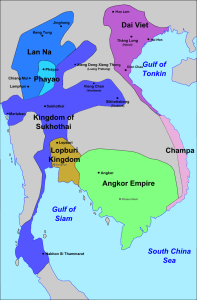
File:Southeast_Asian_history_-_13th_century.png
By Gabby Storey
Trần Thị Dung was born to Trần Lý, leader of the Trần clan in the late twelfth or early thirteenth century. After her family shielded the Crown Prince Lý Sảm during a time of conflict, the pair were married. Her family received high positions at court as a result of their support of the Crown.
In 1211 Lý Sảm was enthroned as Lý Huệ Tông and in February Trần Thị Dung was named as empress consort, however she fell from favour after a year and lost her title. The actions of her family in support of Lý Huệ Tông restored her favour at court. She gave birth to a daughter, Thuận Thiên, in June 1216. Her brothers’ elevation to high positions coincided with her restoration to empress consort in December 1216.
Trần Thị Dung gave birth to a second daughter, Lý Chiêu Hoàng, in September 1218. Upon the abdication of her husband in 1224, Trần Thị Dung became dowager empress consort. However, the actions of her natal family to place her nephew, Trần Cảnh, in power at the expense of her marital family, caused her to lose power and authority at the court. After her husband’s forced suicide, Trần Thị Dung was married to her cousin and regent Trần Thủ Độ
Trần Thị Dung acted as a mediator during civil conflict and was praised by contemporary chroniclers for her role in the reconciliation between the emperor and his brother Trần Liễu. She was also instrumental in governance of the royal household and family matters. Trần Thị Dung died in January 1259. She was named as Mother of the Nation Lady Linh Từ due to the respect owed to her as former empress.
Recommended Reading
Nhung Tuyet Tran, Familial Properties: Gender, State, and Society in Early Modern Vietnam, 1463–1778 (Honolulu: University of Hawaii Press, 2018)
Oscar Chapuis, A history of Vietnam: from Hong Bang to Tu Duc (New York: Greenwood Publishing Group, 1995).
